Henning Rogge
All images by and courtesy of the artist.
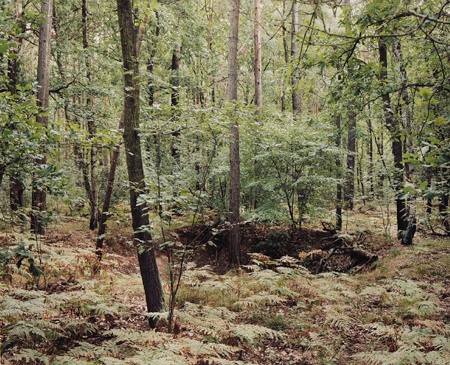
#1 (Stolpe-Süd), 2008, C-type print. 24 x 29.1 inches.
Philosopher Rebecca Comay has succinctly characterized melancholia as ‘the unappeasable attachment to an ungrievable loss’[1]. For those of us in the trenches of psychoanalytic theory, practice and criticism, perhaps one of the first things that comes to mind when looking at Henning Rogge’s powerfully elegiac photographs, which document the craters that were created by Second World War bombings across the German landscape, is Sigmund Freud’s thoughtfully-charged metaphor for melancholia: the open wound.
If one considers the grave as suggestive of being a necessary wounding—an inscription made upon the earth in the name of memory, remembrance, commemoration and an imperative against forgetting, perhaps even the monument to subjective melancholia par excellence—then what does such a wound, that signifies both violence and destruction, represent? What is implicit within the narrative of an absent presence that we might cull from it?
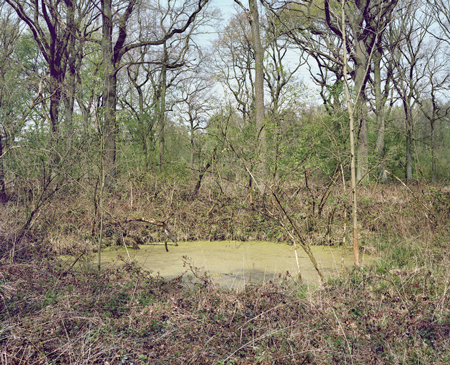
#35 (Beerenbruch), 2010, Chromogenic Color Print. 45.3 x 55.9 inches.
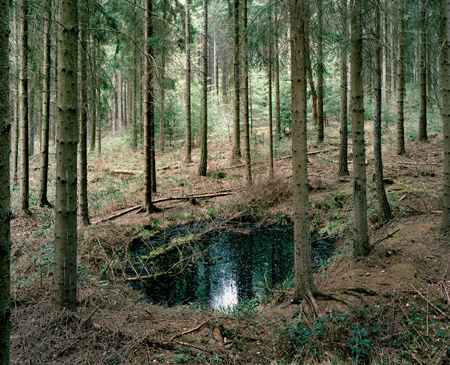
#41 Rotterbach und Hacksiefen), 2010, C-type print. 18.2 x 22 inches.
In the Freudian estimation, the grave behaves precisely like an open wound because ‘[it] draws investment energies to itself from all sides and [drains] the ego to the point of complete impoverishment’[2]. Quite unlike other sorts of consecrated grounds—rigorously fetishized ruins, or state-sanctioned commemorative landmarks or monuments for example—these craters come to metonymically stand in—in their understated presentation—for both a ‘something’ and a ‘nothing’ simultaneously. Rogge himself describes his photographs as landscapes and speaks of such a disconnect in the following terms:
The ambiguity is what interests me the most about these places; the contrast of the calm, almost idyllic appearance of the craters to the sudden force they originated from. The purpose of these bombs was to destroy, now the destruction has slowly transformed into something, life-giving, a habitat for animals, often endangered species. The craters are traces that remain but at the same time show something that is missing; they are visible only as depression in the ground. Maybe one could say they exist somewhere between remembering and forgetting; they are still there, hidden somewhere, but hardly seen or even recognized as what they are.[3]
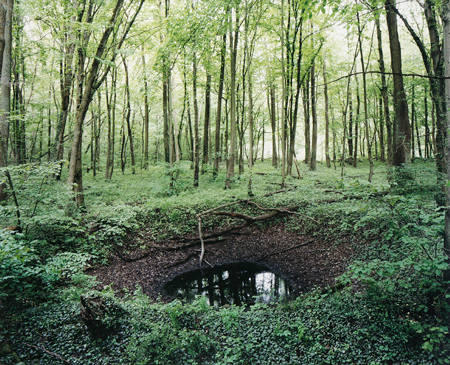
#45 (Bulau), 2010, C-type print. 24 x 29.1 inches.
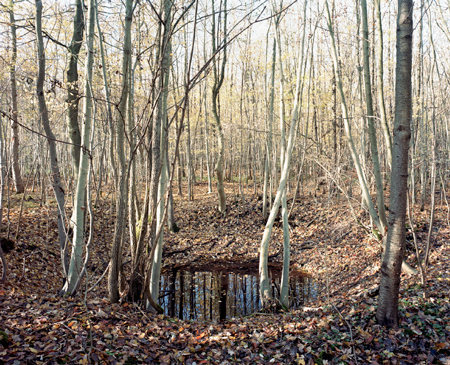
#58 (Projensdorfer Gehölz), 2010, C-type print. 18.2 x 22 inches.
The photographs are forceful despite how still everything within them appears. They cast an aura of profound silence—a quietude that resists being ignored—that, in a sense, seems to hold the viewer within its uncanny auratic capacity somewhere between mourning and melancholia. How, then, does the self of the photograph’s viewer relate to this stagnation—between mourning and melancholia, between remembrance and forgetting—that appears to be implicit in the stillness of these landscapes, landscapes that hold the memory of Germany’s difficult past? Comay on Freud and melancholia becomes rather instructive here again:
Freud’s ‘open wound’ would be the site of an originary extimacy as the subject’s own opening to an infinite responsibility. Buried alive within the vault of a self fractured by the persistence of what cannot be metabolized, the lost object would seem to assert its continued claim on those still alive…[Melancholia’s] tenacity would be the measure of the incommensurability of a loss whose persistence points both to the infinite need for and to the final impossibility of all restitution.[4]

#66 (Mascheroder Holz), 2011, C-type print. 18.2 x 22 inches.
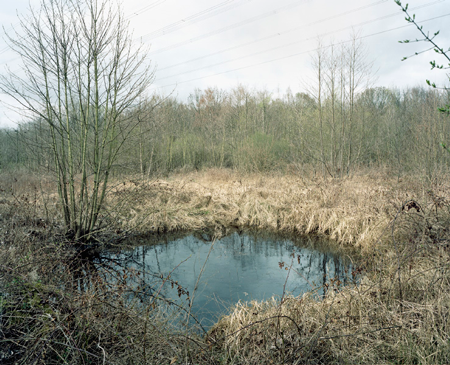
#83 (Beerenbruch), 2012, C-type print. 18.2 x 22 inches.
This becomes the place of inheritance as well. What can we inherit from remembrance, the tried and tiring imperative against forgetting? A loss that persists as such. A loss in its absence and a presence that insists on the memory of that which was lost. Restitution becomes both a need that cannot be fulfilled and an undeniable demand that exists in the ether of how the past is remembered for present life and living.
Palestinian poet Mahmoud Darwish once eloquently said, in a tone that can only be understood as surreptitiously mournful, ‘[Whoever] tells his story will inherit the earth of those words’[5]. One final question that we might want to tarry alongside here would be: who will inherit the wounded earth? How will we think of it, write about it, attempt to stage or represent it as always already stagnating somewhere between mourning and melancholia? Rogge’s images offer one attempt at answering these questions, questions that in their final analysis, concern memory, its painful yet necessary inheritance and its subsequent transmission.
– Ricky Varghese
[1] Comay, Rebecca, ‘The Sickness of Tradition: Between Melancholia and Fetishism,’ in Andrew Benjamin (ed.) Walter Benjamin and History (London: Continuum, 2005), 88.
[2] Freud, Sigmund. ‘Mourning and Melancholia,’ in Adam Phillips (ed.) The Penguin Freud Reader (London: Penguin Books, 2006), 319.
[3] Henning Rogge interview with RH Contemporary in New York.
[4] Comay, 2005, 88.
[5] Darwish, Mahmoud. Why Did You Leave the Horse Alone? (New York: Archipelago Books, 1995), 126.
Henning Rogge is a photographer based in Hamburg, Germany. He received his diploma in visual arts at the University of Applied Sciences Hamburg in 2005. His work has been presented in various exhibitions internationally, at galleries such as the Palais de Tokyo in Paris, REMAP3 in Athens and Deichtorhallen/House of Photography in Hamburg. His practice is characterized by a concentration on long-term projects that address the human relationship to landscape. He is represented by Galerie Jo van de Loo in Munich, Germany and RH Contemporary Art in New York City. www.henningrogge.de
Ricky Varghese received his PhD through the Department of Social Justice Education (formerly known as the Department of Humanities, Social Sciences, and Social Justice Education) at OISE/University of Toronto. He, as well, holds an MA from the same department, and a BSW from York University and an MSW from the University of Toronto’s Faculty of Social Work. He works as a psychotherapist in private practice in downtown Toronto. His research interests extend across the fields of psychoanalytic theory, aesthetics, art criticism and film theory. In the space of art writing, he has written about Gerhard Richter, Vincent Chevalier, Francisco-Fernando Granados, and, more recently, Henning Rogge. He is presently at work on a book project that addresses the temporalities of sex, specifically of barebacking and the time of the future anterior, and the role of AIDS in the history of sexuality as depicted in queer male pornography and in the work of Canadian artist Vincent Chevalier. utoronto.academia.edu/RickyVarghese